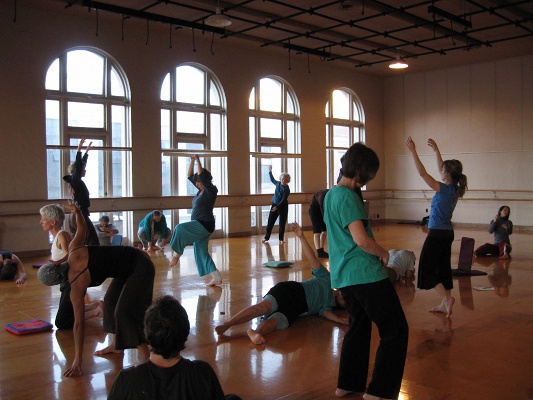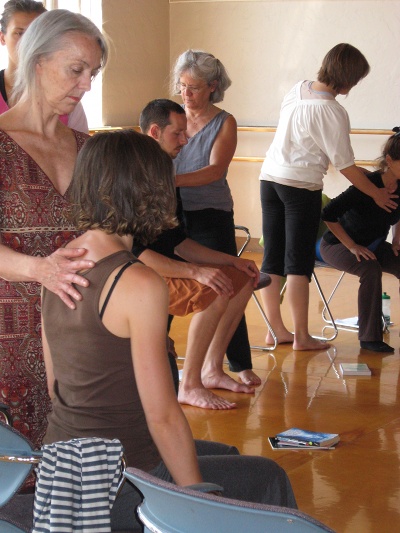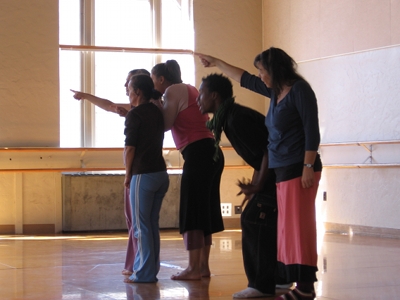|
Artistic Vision Statement | Mission Statement | Faculty | Graduate Profiles
|
|||
|
SOCIAL CHANGE AND ARTISTIC VISION STATEMENT Movement is a key to discovering physical wisdom often lost in a technological society. As co-founders of Moving on Center -- School of Participatory Arts & Research (MOC) we believe there is a gap to be filled in the western world in performance, education and health: GENERATING MOVEMENT in individuals for better health, and amongst groups of people to foster community building. Dance and other live arts can awaken responsibility to one's personal self and to the community one participates in. We envision helping to inspire a shift from a society of overworked, isolated people to groups of interactive, creative and responsive people. We see this shift occurring through the informed work of our graduates, faculty and students in schools, community centers, theaters, and health facilities, and in classes, performances, and informal gatherings on-site at MOC.
The school is designed for personal and professional growth and creates an environment for all interested people to educate their bodies in alignment with humanitarian values. The highest quality of work in the fields of dance, dance science, movement education, group facilitation, and somatic movement therapy are drawn upon from both community and international sources. This need is not currently filled by any single institution in the U.S.A. MOC will establish a much needed base in the Bay Area for focusing the excellent but dispersed teaching that already exists here, as well as inviting out-of-town leaders of interdisciplinary performance and somatic thinking to regularly share their work here. MOC will act within an international network of artists, educators and schools. These will initially include Naropa, Movement Research, the Laban / Bartenieff Institute of Movement Studies, the School for Body-Mind Centering, college and university dance instructors and departments, dance therapy, theater and somatics departments in the U.S.A. and Canada, EUROLAB, the International Association for Dance Medicine and Science, and the School for New Dance Development in Amsterdam, further enhancing the interchange of somatic theories and new performance ideas.
As a research center, MOC engages in developing new models of learning and the systematic investigation of movement behavior while embracing the history and evolution of established movement forms and modes of inquiry. We highlight a shift from authoritarian styles of instruction to the recognition of personal authority within cooperative activities and projects. Critical thinking is encouraged, leading to constructive methods of seeing and responding to art. The ability to question and determine personal values is paramount. Students will create frameworks for critiquing art work and therapeutic interventions that acknowledge their biases. Observers will learn to witness and share responses within social and cultural contexts while testing and researching their own internal logic. Appreciation of diversity assisted by improved verbal and nonverbal communication is a valued outcome. In somatic movement therapy, cooperation is also central: for example, the client and therapist work together to problem solve -- time is taken to hear the life stories and practical concerns of clients and clients are engaged in becoming educated about their bodies. They are thereby empowered to make informed choices about their healing steps, and new movement and physical options are discovered and chosen together. This cooperative relationship provides pivotal support when decisions about personal attitudes, work and personal life are being considered. Somatic movement therapy is a unique form of advocacy that engages the client in a creative process regarding their health, suiting the needs of dancers, athletes, performers and the general population. MOC's training program includes the Somatic Movement Therapy Trainingsm to provide a professional framework for its graduates. Upon completion of all requirements, they can apply to work under the newly established Department of Labor professional title of Registered Movement Therapists. Registered Movement Therapists often choose to work interactively with medical specialists, alternative health practitioners, fitness specialists, and as health advocates for people with a range of conditions and disabilities. Ideally, the educational environment is filled with a sense of inspiration and excitement as well as contemplative focus. Learning at MOC includes nature expeditions while also benefiting from the pulse of the urban lifestyle. Participatory art moves us into a model of culture which symbolizes and actively communicates our common purposes. This is most effective when a wide variety of students gather.
By bridging the ARTS-SCIENCE-EDUCATION-HEALTH disciplines we are linking POLARITIES. Through the interface of many artistic and theoretical systems (body-mind disciplines, dance science, design, history, kinesiology, motor learning, videography, etc.) we anticipate the emergence of new forms of leadership and social action. Our doors are open to adults of all ages and talents, respecting both youthful idealism and emotional maturity as important resources to the advancement of the bodily arts and sciences. We experience moving and creating as synonymous and recognize creative expression as a basic need that feeds the soul. Knowing that art can stimulate controversy, and that conflicts exist within and between groups, we also emphasize that non-violent expression and release of tension through the body can help to generate new solutions, particularly when we are taught to listen and reflect upon body-mind wisdom. This sensitivity to expanding ranges of perception and expression increases personal vitality and appreciation of differences, thereby enhancing the overall health of communities. As co-founders of MOC, we believe there are many keys that unlock potential -- one powerful key is human movement. We invite you to move to support this vision in your own unique way. Martha Eddy & Carol Swann
Photos provided by Susan Bauer and Vitali Kononov
|
|||


 In a time when individualism has become an assumed value within western culture, we as a group of artists, educators and health practitioners feel the critical need to teach and use cooperation; cooperative learning and problem-solving are the starting points for conflict resolution, leading edge business management, and progressive education. Working together physically is a type of embodied cooperation that integrates the use of the body and mind. This is the basis for Contact Improvisation and Somatic Movement Therapysm, as well as for many traditional dance, movement and healing forms that have influenced them. MOC's educational certification program weds skills from the performance and health fields through training in contact improvisation, movement therapy, live music, theater arts, dance science and experimental dance. At MOC, diverse people can gain a balance of knowledge to meet both their creative drive through participatory performance training and their practical needs for employment through training in professions that welcome the creative spirit -- movement therapy and professional group and conflict facilitation.
In a time when individualism has become an assumed value within western culture, we as a group of artists, educators and health practitioners feel the critical need to teach and use cooperation; cooperative learning and problem-solving are the starting points for conflict resolution, leading edge business management, and progressive education. Working together physically is a type of embodied cooperation that integrates the use of the body and mind. This is the basis for Contact Improvisation and Somatic Movement Therapysm, as well as for many traditional dance, movement and healing forms that have influenced them. MOC's educational certification program weds skills from the performance and health fields through training in contact improvisation, movement therapy, live music, theater arts, dance science and experimental dance. At MOC, diverse people can gain a balance of knowledge to meet both their creative drive through participatory performance training and their practical needs for employment through training in professions that welcome the creative spirit -- movement therapy and professional group and conflict facilitation. Somatic theory provides fundamental and experiential knowledge about the body and movement, essential for the performing artist and health practitioner. It also serves as a historical culmination of groundbreaking European health and dance developments of the early part of this century, and embraces principles from ancient Asian movement, martial arts and meditation forms (e.g., aikido, chi kung, tai chi, and yoga). It brings forth the best in multi-modal teaching methodologies, particularly providing a path for kinesthetic learners which is so often neglected in traditional education. In other words, somatic theories act to inform the creation of art, manners of educating, and therapeutic methods. As the artist infuses health, education and therapy with the creative process, these fields are impacted in new and significant ways. In turn, the artist and arts in general are propelled by the infusion of scientific knowledge and empirical research.
Somatic theory provides fundamental and experiential knowledge about the body and movement, essential for the performing artist and health practitioner. It also serves as a historical culmination of groundbreaking European health and dance developments of the early part of this century, and embraces principles from ancient Asian movement, martial arts and meditation forms (e.g., aikido, chi kung, tai chi, and yoga). It brings forth the best in multi-modal teaching methodologies, particularly providing a path for kinesthetic learners which is so often neglected in traditional education. In other words, somatic theories act to inform the creation of art, manners of educating, and therapeutic methods. As the artist infuses health, education and therapy with the creative process, these fields are impacted in new and significant ways. In turn, the artist and arts in general are propelled by the infusion of scientific knowledge and empirical research. Our dream is to make this information practical, and the educational experience within the reach of all people interested. We are aware that the cost of this specialized training makes it affordable to only a limited number of students. With opportunities for work-study, scholarships and student loans, we hope to bring the possibility of this work within the scope of more students. Additionally, our new structure of separate modules, as well as individual workshops which can be taken independently, allows students to pursue the course of study at their own pace, which also moderates the financial impact. MOC anticipates evolving and changing as new groups of people bring their learning styles and vision to the school, and we hope to increase the availability of this program.
Our dream is to make this information practical, and the educational experience within the reach of all people interested. We are aware that the cost of this specialized training makes it affordable to only a limited number of students. With opportunities for work-study, scholarships and student loans, we hope to bring the possibility of this work within the scope of more students. Additionally, our new structure of separate modules, as well as individual workshops which can be taken independently, allows students to pursue the course of study at their own pace, which also moderates the financial impact. MOC anticipates evolving and changing as new groups of people bring their learning styles and vision to the school, and we hope to increase the availability of this program.